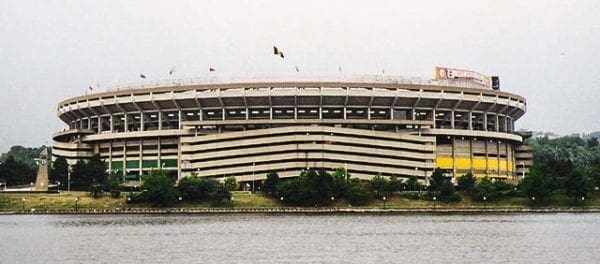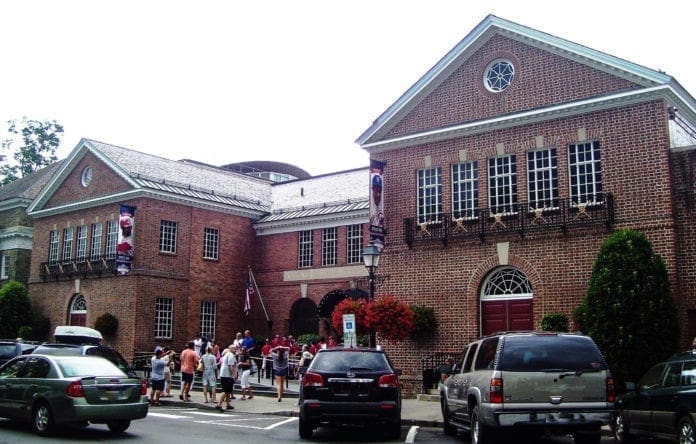Seen a show lately at the Burgettstown spot called Keybank Pavilion? Or is it still Post-Gazette Pavilion? First Niagara?
No matter. You go and see one of your favorites, and it’s still Star Lake Amphitheater. You can change the name, but you know what you’re getting: A nice place to see a show, followed by two or three hours of trying to escape the parking lot.
You certainly won’t see Harold Baines there. That’s because Harold is in the National Baseball Hall of Fame, and he was put in there last year by the Veterans’ Committee, which now goes by the Eras’ Committee Panel, but those fellows – 16 of them — ought to try their vaudeville act at Star Lake, because they botched last year’s vote with embarrassing hilarity.
Now don’t get me wrong — Harold was not a bad player. Far from it. His 20-year career, mostly as a designated hitter, was very good, in fact. But nobody — and I mean nobody — ever watched Harold Baines in his prime and said, “Son, there goes a Hall of Famer.”
Which brings us to this week’s news that the Modern Era Committee has named 10 candidates to be discussed and voted upon next month for baseball immortality: Induction into the HoF in Cooperstown. They’ll gather at the Winter Meetings in San Diego, kick the candidates around and then vote. All 10 candidates are rock-solid. And … I doubt if any of the players will make it.
Harold Baines had the backing of two alpha dogs on the committee: Tony LaRussa and Jerry Reinsdorf. Hard to say what factors they brought to the table to sway the vote. From Sports Illustrated: “There’s no real argument for Baines as a Hall of Famer. If you can put one together, it’s probably a bad one. You’d have an easier time making a case that he’s one of the worst Hall of Famers ever.”
So, we’ve lowered the bar to ground level as we await to see how the new normal plays out this time. The nine former players up for the honor include two first-time Veterans’ candidates: Lou Whitaker and Dwight Evans, along with former Pirates great Dave Parker, Steve Garvey, Don Mattingly, Tommy John, Ted Simmons, Thurman Munson, and Dale Murphy. All excellent players. Also up is Marvin Miller, the brash Players Association union kingpin who led the charge for free agency and, truth be told, should’ve been in the HoF long ago. You can’t tell the story of Major League Baseball without talking extensively about Marvin Miller’s historic career.
Here’s the problem with this committee. There are 16 voters limited to four votes apiece. That’s 64 total votes. (Stick with me here). The candidates have to get a minimum of 12 votes for enshrinement. The list is so strong that the players will cannibalize each other’s votes. You’ll end up with somebody maybe getting 10, a few with 7-8 votes, and a couple with 2-3. The math just doesn’t add up. Unless, of course, LaRussa likes you and the veneer of fairness dissolves to cronyism again.
The Harold Factor dictates that all of these players are worthy. The Marvin Factor dictates that crucial votes will be cast for an executive instead of a player. I firmly believe that Marvin Miller is the top candidate here, but he said many times before dying in 2012 that he didn’t want to be elected posthumously. Any exec, manager, owner or umpire should have his own day, in his own category. I’d rather celebrate a living player.

And I’d rather it be Dave Parker.
Easily one of the best Pirates of my lifetime – I’ll go Roberto, Stargell, Maz, Bonds, Parker and Cutch – this dude was a fearsome force in the late 70s, considered by many as the best player in the game from 1975-81. He won the NL MVP in 1978 after winning his second straight batting title, then took 1979 All-Star Game MVP honors by flashing his phenomenal throwing arm on a couple of dazzling plays from right field. He was the No. 3 hitter on the ’79 World Champion Pirates, had the best arm in baseball and could run, too – he stole 20 bases in 24 attempts in 1979. He was a team leader (the brash to Stargell’s class), and he played with an edge that was almost scary.
If you saw the 6-5, 230-pound Dave Parker play in his heyday, you knew in your heart and soul: “This is what a Hall of Famer looks like in his prime.”
The Pirates thought so, too. They made him the game’s first-ever million-dollar player with a startling contract that didn’t seem to impress the folks in his economically depressed city. The honeymoon was over. Parker fought back with the fans verbally, then succumbed to the demons of cocaine, gained weight, and was ushered out of town.
He hooked on with the Reds and found his mojo again. In 1985, he was as strong as ever, with 34 HRs, 42 doubles, 125 RBIs and a .312 BA, and finished second in the NL MVP voting to Willie McGee. After two more excellent seasons for the Reds in 1986-87, Parker was off to Oakland, and in 1989 had 22 HRs and 97 RBIs for the World Champion A’s.
But the year of 1985 – one of Parker’s very best years on the field — was the worst ever for his legacy, and the big buzzkill for his HoF candidacy. That’s the year the MLB drug trials went down in Pittsburgh, and Parker was the face of it all, fair or not. It was a stain that seems to be trying to fade a little as Parker is now considered a legit candidate after topping out at 24.5 percent on 15 writers’ ballots. Keep in mind, Paul Molitor and Dennis Eckersley both had ties to cocaine and have been voted in.
Can he overcome? I have my doubts. It’s the tricky math more than anything.
A quick look at the other candidates:
Don Mattingly — This cat passed the eye test. Donnie Baseball was the classic player, with pop in the bat and pizzazz in the mitt. One of the truly great hitters in the mid-80s, Mattingly won nine Gold Gloves at 1B and won the AL MVP in 1985. A back ailment hit him in 1990, and he was never really the same player. Brilliant peak, but the career “compiler” numbers just aren’t there. But he’s better than Baines.
Thurman Munson — The epitome of a Yankee catcher and team captain. Munson played 11 seasons before dying in a plane crash in Canton, Ohio. He was AL MVP in 1976, made the All-Star game seven times and won three Gold Gloves. If he could’ve played 2-3 more years (he died at 32) he would be on the Yadier Molina level — a no doubt HoF’er.
Dale Murphy — Those who watched him play in the 1980’s are wondering how in the world he’s not in the HoF already. And yet stat geeks who quantify players on pure production numbers wonder how he ever got this far in the process. (A question for the geeks: If WAR is such a coverall stat, why are there so many versions? You’ve got fWAR and rWAR or bWAR, and now WARP. Wait … did WARP ever play Star Lake?) Anyway, that’s the argument facing Murphy, who won two NL MVP’s for the Braves (’82-83) and earned five Gold Gloves as a CF after initially starting his career at catcher. Pretty impressive to me.
Tommy John — I’m guessing some of the millennials think of Tommy John as either a famous orthopedist or maybe an actor who played The Six Million Dollar Man on TV. But the “original Tommy John surgery guy” was a fine pitcher who, after his landmark left arm ligament reconstruction, went on to pitch 14 more years after his surgery — he pitched until he was 46 — and never missed another start. He won 288 career games with an ERA of 3.34. The list of players who have won 288 games since 1901 and not made the HoF: 1. Roger Clemens. 2. Tommy John.
Steve Garvey — Another remarkable player whose career has been besmirched by the stat nerds. WAR is hell for Garvey. To me, he’s one of the great clutch hitters of the past 50 years and winning seemed to follow him around. The 1B won the NL MVP in 1974, had six 200-hit seasons, won four Gold Gloves, and was a 10-time All-Star. In fact, Garvey was an annual starter in the ASG, usually hitting 3-4-5 in the lineup, and was MVP in two of them. He was also MVP twice in the NLCS. Again, during his career Garvey was a player you always assumed would be a HoF’er. Again, better than Baines.
Ted Simmons — The former Cardinal catcher fell just one vote short on the Veterans’ Committee ballot in 2018, so it’ll be interesting to see how this plays out. Simmons is certainly worthy of the Hall. He was an eight-time All-Star and one of the best hitters to ever play the position. I would vote for Ted Simmons in a heartbeat, although most writers wouldn’t make that claim. Simmons was on the writers’ ballot but one year, getting 3.7 percent of the vote. Egads.
Dwight Evans — Interesting career. His first few seasons he was known was a fantastic defensive player who could hit a little, as the power numbers increased gradually. Then he caught a jetstream and — from ages 30 through 37 — averaged 26 HRs, 100 runs scored, 96 RBIs, with a glorious OPS of .881. In the American League in the 1980s, Dewey Evans hit more HRs (256) and had more extra base hits (605) than anybody. Oh, and he won eight Gold Gloves in RF. Great player.
Lou Whitaker — Like Evans, it’s his first shot at the Veterans’ Committee. Whitaker will forever be linked with longtime keystone partner Alan Trammell, who was voted in by the Veterans Committee in 2018. They played 1,918 MLB games together, an all-time record. Whitaker’s career pretty much mirrors Trammell’s, in fact. Whitaker won three Gold Gloves and a Rookie of the Year Award. The writers didn’t take note: Sweet Lou Whitaker received just 2.9 percent of the vote his only year on the ballot.
Prediction: It’s hard to know without knowing the room at the Winter Meetings. I couldn’t find a list of the selection committee members online. Pretty hush-hush stuff. Joe Torre was there last year. He may get Simmons through. Greg Maddux, if he’s back, may push for Murphy. Whitaker and Evans are strong first-year candidates. And Miller’s omission is a disgrace.
The Harold Factor hovers over it all. That’s how it works now.


